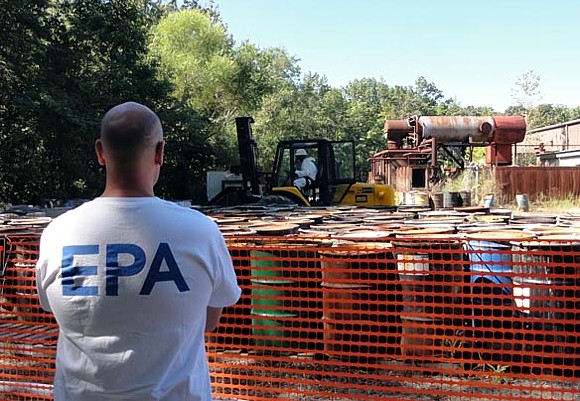The U.S Environmental Protection Agency has received a warrant allowing it to go in and clean up an abandoned New Jersey drum and container recycling facility that was also a wholesale industrial supplier. The site was storing numerous toxic materials and chemicals.
 EPA toxic chemical cleanup at the abandoned Superior Barrel and Drum facility, a former drum and container recycling site that was also a wholesale industrial supplier in Elk Township, N.J. Photo courtesy of the EPA.
EPA toxic chemical cleanup at the abandoned Superior Barrel and Drum facility, a former drum and container recycling site that was also a wholesale industrial supplier in Elk Township, N.J. Photo courtesy of the EPA.The site, formerly owned by the Superior Barrel and Drum company, located in a rural, wooded area of Elk Township, N.J., was found in disrepair with over 2,000 containers, with mostly 55-gallon drums and 275-gallon totes that could be seen from the road.
Local and Gloucester County officials discovered the facility in its deteriorated state. The New Jersey Department of Environmental Protection (NJDEP) and county HazMat were contacted and identified the hazardous substances.
County officials said that attempts to reach the property owner failed on numerous occasions. The owner filed for bankruptcy in 2012, but the case was dismissed due to lack of information provided by the plaintiff.
Elk Township was planning on foreclosure proceedings due to back property taxes owed, but the Gloucester County Fire Marshal’s Office recommended they hold off on the proceedings because of site conditions.
The NJDEP brought the EPA in on the project because of the size of the undertaking and the amount of resources needed.
The EPA said, “Many containers were found to be leaking, without tops, exposed to weather elements, rusted, damaged due to gunshots, stored improperly, and laying on their sides.
“Several drums and containers were found in standing water throughout the property, and many were located within the onsite wetlands. These wetlands are included in the National Wetlands Inventory, administered by the U.S. Fish and Wildlife Service.”
The EPA collected 84 samples for analysis from on-site containers, surface soil and surface water. The results found chemicals, many of them carcinogens, including benzene, toluene, trichloroethylene, ethylbenzene, xylenes, polychlorinated biphenyls (PCBs), and lead.
“Many of these compounds were found in containers that are actively leaking onto surface soils,” added the agency.
The EPA said that its “top priority is preventing a release, fire, or explosion that could endanger the community or (further) pollute the environment.”
The agency said that exposure to these pollutants, citing benzene and lead as examples, could have serious health consequences.
The EPA explained that, “Benzene is known to cause cancer and lead is a toxic metal that is especially dangerous to children because their growing bodies absorb more of it than adults.
“Lead in children can result in I.Q. deficiencies, reading and learning disabilities, reduced attention spans, hyperactivity, and other behavioral problems.”
The EPA said to prevent materials from migrating off the facility’s property, it has installed protective berms (raised barriers separating two areas) to stop materials from spreading.
This is also expected to act as an engineering control should a larger release occur. The agency adds that, “All material will be held in the containment cell preventing migration to surface waters or neighboring properties.”
Fencing has also been placed around the site where it borders a public road to prevent the public from coming into contact with containers or hazardous materials.
In addition, hand-held air monitoring equipment is being used whenever containers are inspected, opened, and sampled. Air monitoring stations have also been set up in several locations around the perimeter of the site and in areas where crews are working.
The EPA said that the air sensors have been set up to detect airborne contaminants, sound alarms and notify personnel to close containers. The agency said that if the alarms go off, operations will stop and work will be re-evaluated prior to restarting activities.
Further, the EPA said that security guards have been posted near the entrance of the facility in order to discourage the public from entering the site.
Before removing the hazardous materials, the EPA said it will develop a contingency plan to ensure that the removal process is done safely.
The agency said that “fire department and hazardous materials response teams will be consulted, and prepared to respond to the site if necessary. The EPA added that “throughout the cleanup, the municipal government and local community will be kept informed.
Funding for this project is being provided through the federal Superfund program, administered by the EPA, and not through local tax revenues, said the agency.
Reader comments and input are always welcomed!